Clinical Research Skills: Analysis of LBP_Final.sav SPSS Data Report
VerifiedAdded on 2023/01/13
|11
|1807
|25
Report
AI Summary
This report presents an analysis of clinical research data from the SPSS file LBP_Final.sav, focusing on subjects who returned for a 3-month assessment. The analysis includes creating new variables, generating quality tables summarizing demographic and clinical variables, and constructing publication-quality bar charts. The report justifies the choice of plots, identifies suitable statistical tests (t-test, chi-square), assesses relationships between variables (VAS2CAT and GROUP), and proposes a suitable regression model. It also details the statistical methods employed (descriptive analysis, regression, correlation) and concludes with key findings regarding the data's distribution and variable comparisons, particularly concerning VAS1 and VAS2 scores and their relationship to other variables like age and gender. The report emphasizes the importance of clinical research skills, including data analysis, GCP compliance, and safety management.
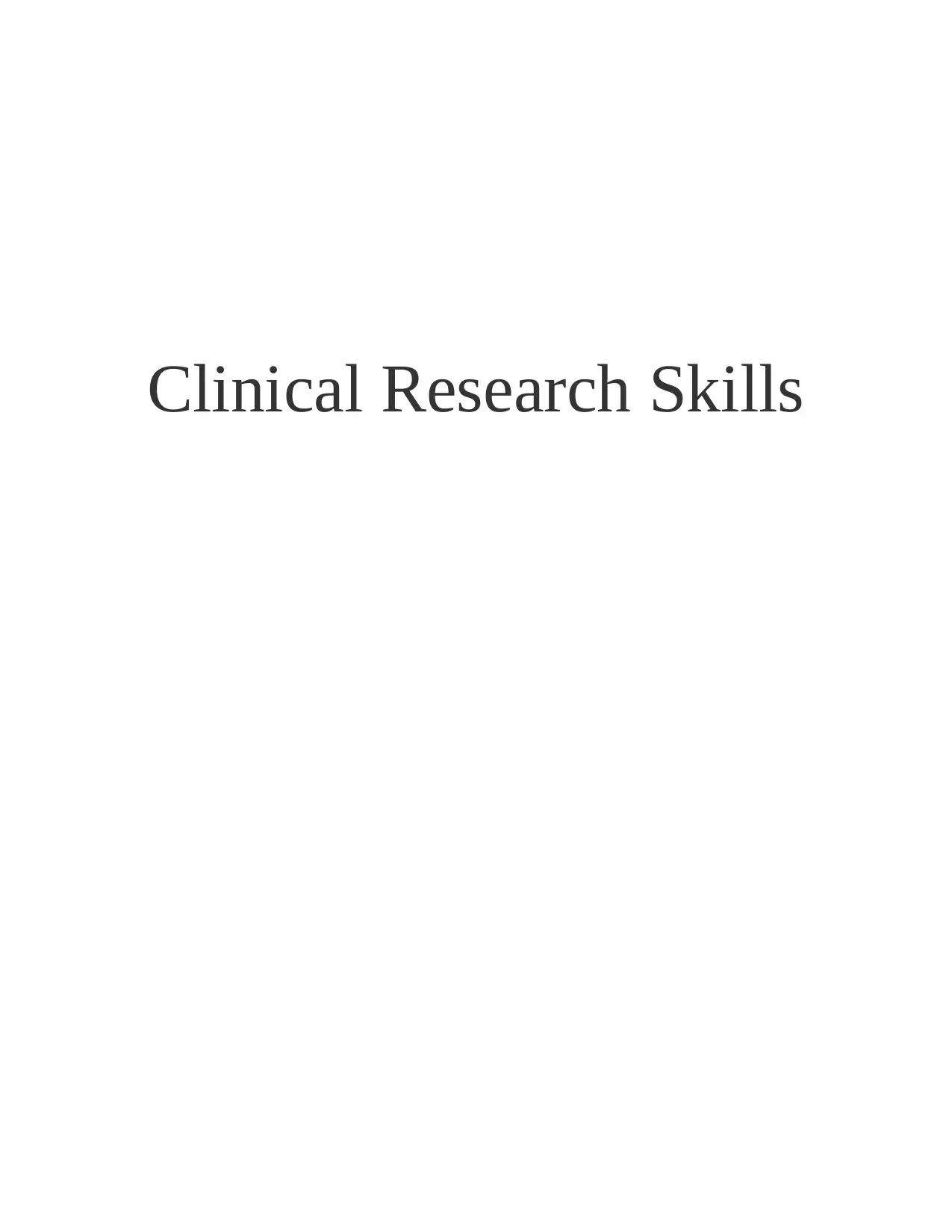
Clinical Research Skills
Paraphrase This Document
Need a fresh take? Get an instant paraphrase of this document with our AI Paraphraser
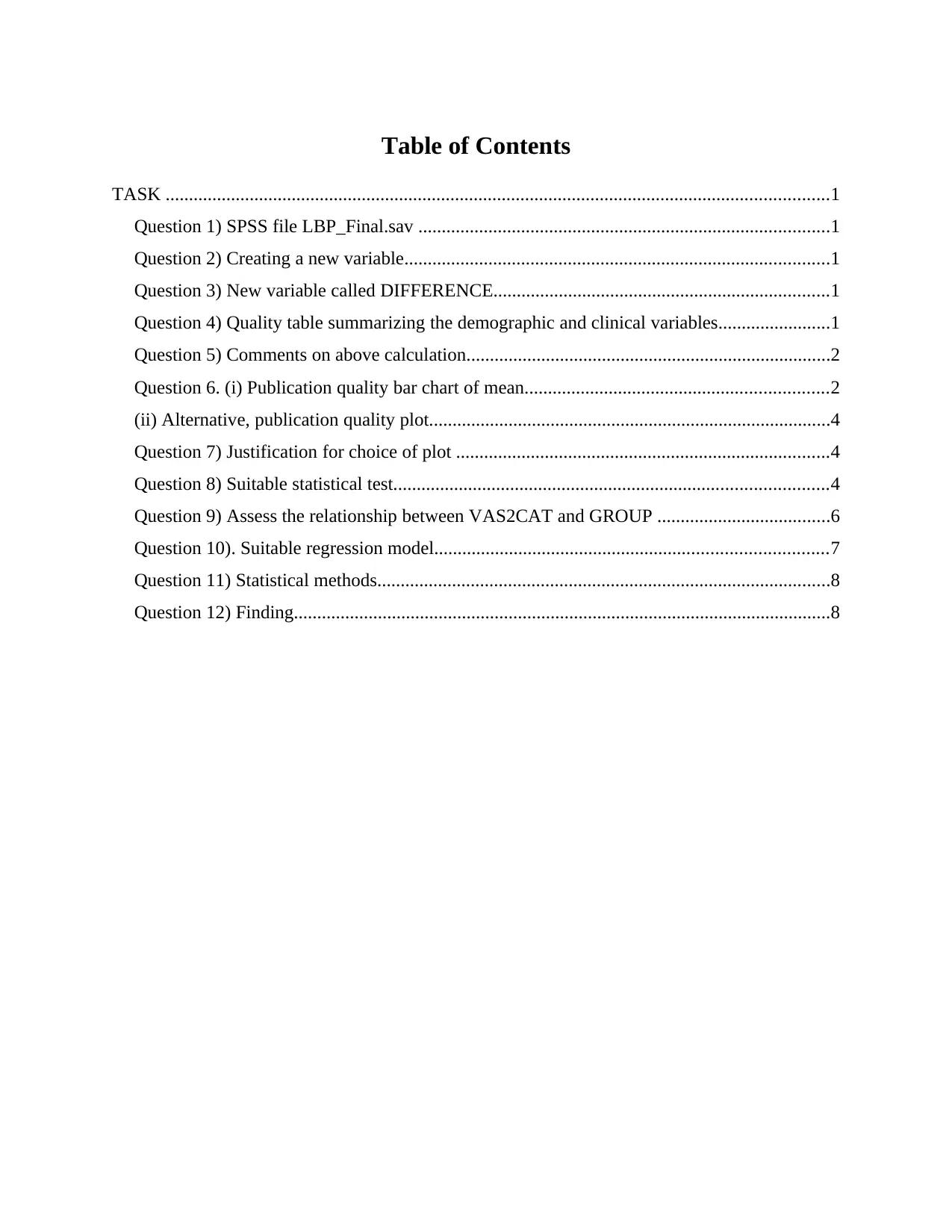
Table of Contents
TASK ..............................................................................................................................................1
Question 1) SPSS file LBP_Final.sav ........................................................................................1
Question 2) Creating a new variable...........................................................................................1
Question 3) New variable called DIFFERENCE........................................................................1
Question 4) Quality table summarizing the demographic and clinical variables........................1
Question 5) Comments on above calculation..............................................................................2
Question 6. (i) Publication quality bar chart of mean.................................................................2
(ii) Alternative, publication quality plot......................................................................................4
Question 7) Justification for choice of plot ................................................................................4
Question 8) Suitable statistical test.............................................................................................4
Question 9) Assess the relationship between VAS2CAT and GROUP .....................................6
Question 10). Suitable regression model....................................................................................7
Question 11) Statistical methods.................................................................................................8
Question 12) Finding...................................................................................................................8
TASK ..............................................................................................................................................1
Question 1) SPSS file LBP_Final.sav ........................................................................................1
Question 2) Creating a new variable...........................................................................................1
Question 3) New variable called DIFFERENCE........................................................................1
Question 4) Quality table summarizing the demographic and clinical variables........................1
Question 5) Comments on above calculation..............................................................................2
Question 6. (i) Publication quality bar chart of mean.................................................................2
(ii) Alternative, publication quality plot......................................................................................4
Question 7) Justification for choice of plot ................................................................................4
Question 8) Suitable statistical test.............................................................................................4
Question 9) Assess the relationship between VAS2CAT and GROUP .....................................6
Question 10). Suitable regression model....................................................................................7
Question 11) Statistical methods.................................................................................................8
Question 12) Finding...................................................................................................................8
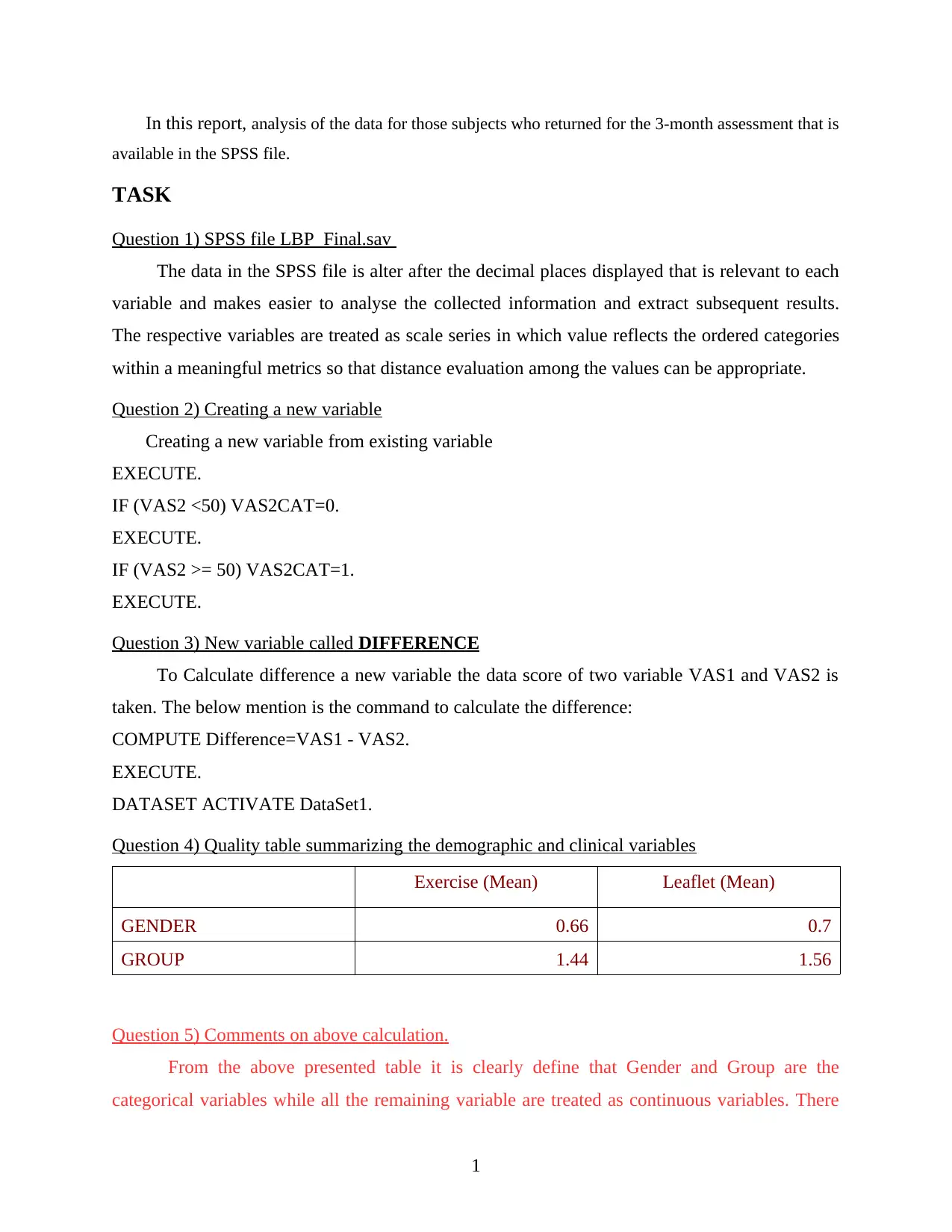
In this report, analysis of the data for those subjects who returned for the 3-month assessment that is
available in the SPSS file.
TASK
Question 1) SPSS file LBP_Final.sav
The data in the SPSS file is alter after the decimal places displayed that is relevant to each
variable and makes easier to analyse the collected information and extract subsequent results.
The respective variables are treated as scale series in which value reflects the ordered categories
within a meaningful metrics so that distance evaluation among the values can be appropriate.
Question 2) Creating a new variable
Creating a new variable from existing variable
EXECUTE.
IF (VAS2 <50) VAS2CAT=0.
EXECUTE.
IF (VAS2 >= 50) VAS2CAT=1.
EXECUTE.
Question 3) New variable called DIFFERENCE
To Calculate difference a new variable the data score of two variable VAS1 and VAS2 is
taken. The below mention is the command to calculate the difference:
COMPUTE Difference=VAS1 - VAS2.
EXECUTE.
DATASET ACTIVATE DataSet1.
Question 4) Quality table summarizing the demographic and clinical variables
Exercise (Mean) Leaflet (Mean)
GENDER 0.66 0.7
GROUP 1.44 1.56
Question 5) Comments on above calculation.
From the above presented table it is clearly define that Gender and Group are the
categorical variables while all the remaining variable are treated as continuous variables. There
1
available in the SPSS file.
TASK
Question 1) SPSS file LBP_Final.sav
The data in the SPSS file is alter after the decimal places displayed that is relevant to each
variable and makes easier to analyse the collected information and extract subsequent results.
The respective variables are treated as scale series in which value reflects the ordered categories
within a meaningful metrics so that distance evaluation among the values can be appropriate.
Question 2) Creating a new variable
Creating a new variable from existing variable
EXECUTE.
IF (VAS2 <50) VAS2CAT=0.
EXECUTE.
IF (VAS2 >= 50) VAS2CAT=1.
EXECUTE.
Question 3) New variable called DIFFERENCE
To Calculate difference a new variable the data score of two variable VAS1 and VAS2 is
taken. The below mention is the command to calculate the difference:
COMPUTE Difference=VAS1 - VAS2.
EXECUTE.
DATASET ACTIVATE DataSet1.
Question 4) Quality table summarizing the demographic and clinical variables
Exercise (Mean) Leaflet (Mean)
GENDER 0.66 0.7
GROUP 1.44 1.56
Question 5) Comments on above calculation.
From the above presented table it is clearly define that Gender and Group are the
categorical variables while all the remaining variable are treated as continuous variables. There
1
⊘ This is a preview!⊘
Do you want full access?
Subscribe today to unlock all pages.

Trusted by 1+ million students worldwide
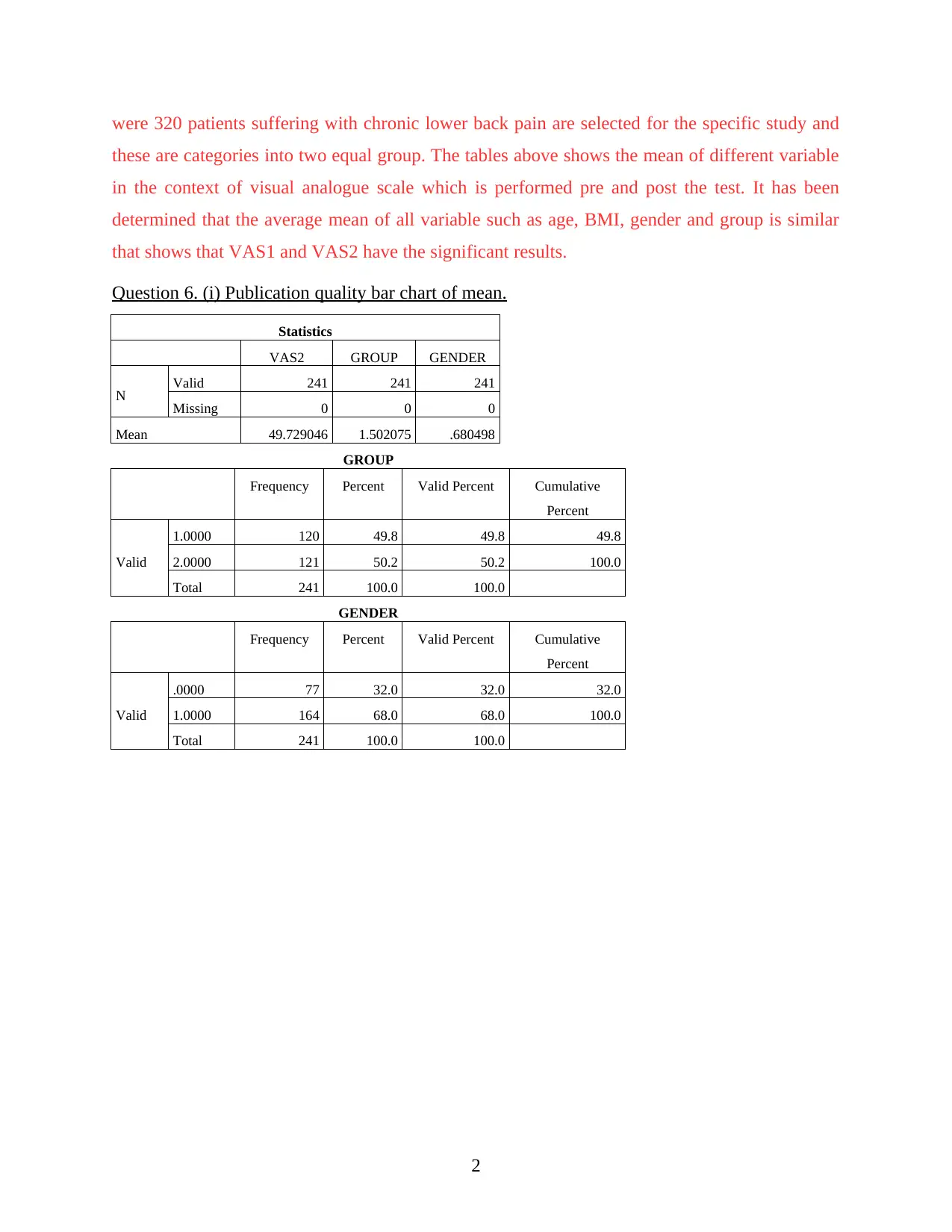
were 320 patients suffering with chronic lower back pain are selected for the specific study and
these are categories into two equal group. The tables above shows the mean of different variable
in the context of visual analogue scale which is performed pre and post the test. It has been
determined that the average mean of all variable such as age, BMI, gender and group is similar
that shows that VAS1 and VAS2 have the significant results.
Question 6. (i) Publication quality bar chart of mean.
Statistics
VAS2 GROUP GENDER
N Valid 241 241 241
Missing 0 0 0
Mean 49.729046 1.502075 .680498
GROUP
Frequency Percent Valid Percent Cumulative
Percent
Valid
1.0000 120 49.8 49.8 49.8
2.0000 121 50.2 50.2 100.0
Total 241 100.0 100.0
GENDER
Frequency Percent Valid Percent Cumulative
Percent
Valid
.0000 77 32.0 32.0 32.0
1.0000 164 68.0 68.0 100.0
Total 241 100.0 100.0
2
these are categories into two equal group. The tables above shows the mean of different variable
in the context of visual analogue scale which is performed pre and post the test. It has been
determined that the average mean of all variable such as age, BMI, gender and group is similar
that shows that VAS1 and VAS2 have the significant results.
Question 6. (i) Publication quality bar chart of mean.
Statistics
VAS2 GROUP GENDER
N Valid 241 241 241
Missing 0 0 0
Mean 49.729046 1.502075 .680498
GROUP
Frequency Percent Valid Percent Cumulative
Percent
Valid
1.0000 120 49.8 49.8 49.8
2.0000 121 50.2 50.2 100.0
Total 241 100.0 100.0
GENDER
Frequency Percent Valid Percent Cumulative
Percent
Valid
.0000 77 32.0 32.0 32.0
1.0000 164 68.0 68.0 100.0
Total 241 100.0 100.0
2
Paraphrase This Document
Need a fresh take? Get an instant paraphrase of this document with our AI Paraphraser
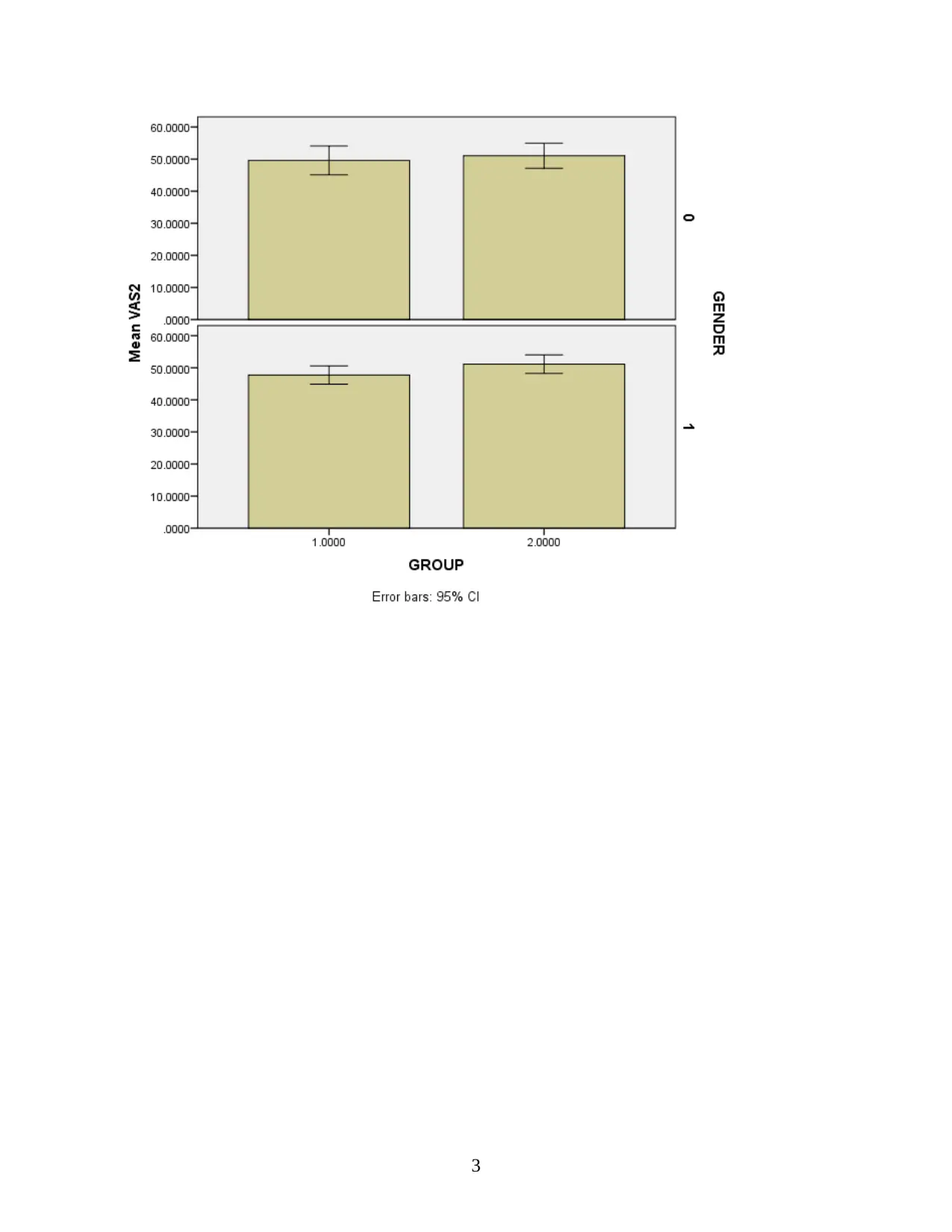
3
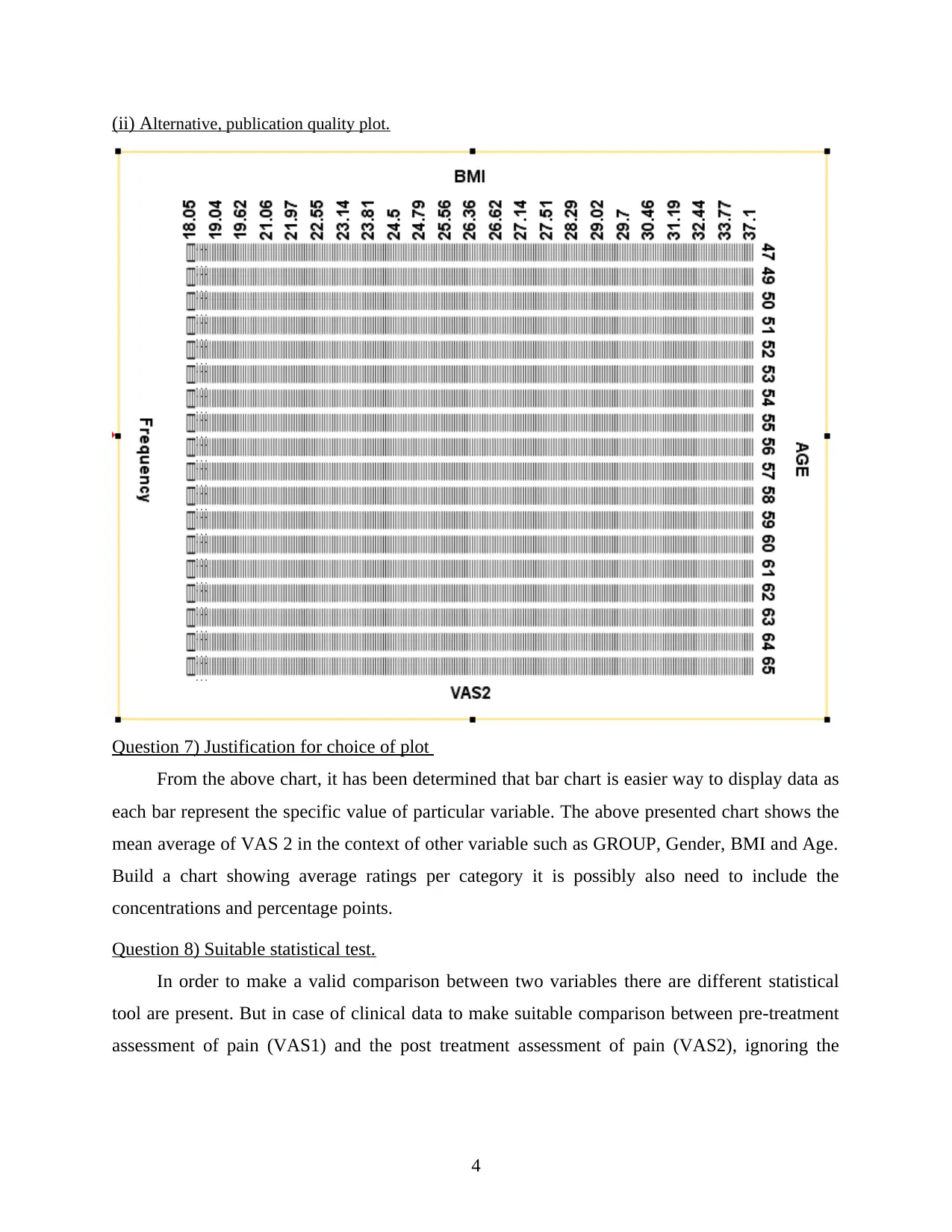
(ii) Alternative, publication quality plot.
Question 7) Justification for choice of plot
From the above chart, it has been determined that bar chart is easier way to display data as
each bar represent the specific value of particular variable. The above presented chart shows the
mean average of VAS 2 in the context of other variable such as GROUP, Gender, BMI and Age.
Build a chart showing average ratings per category it is possibly also need to include the
concentrations and percentage points.
Question 8) Suitable statistical test.
In order to make a valid comparison between two variables there are different statistical
tool are present. But in case of clinical data to make suitable comparison between pre-treatment
assessment of pain (VAS1) and the post treatment assessment of pain (VAS2), ignoring the
4
Question 7) Justification for choice of plot
From the above chart, it has been determined that bar chart is easier way to display data as
each bar represent the specific value of particular variable. The above presented chart shows the
mean average of VAS 2 in the context of other variable such as GROUP, Gender, BMI and Age.
Build a chart showing average ratings per category it is possibly also need to include the
concentrations and percentage points.
Question 8) Suitable statistical test.
In order to make a valid comparison between two variables there are different statistical
tool are present. But in case of clinical data to make suitable comparison between pre-treatment
assessment of pain (VAS1) and the post treatment assessment of pain (VAS2), ignoring the
4
⊘ This is a preview!⊘
Do you want full access?
Subscribe today to unlock all pages.

Trusted by 1+ million students worldwide
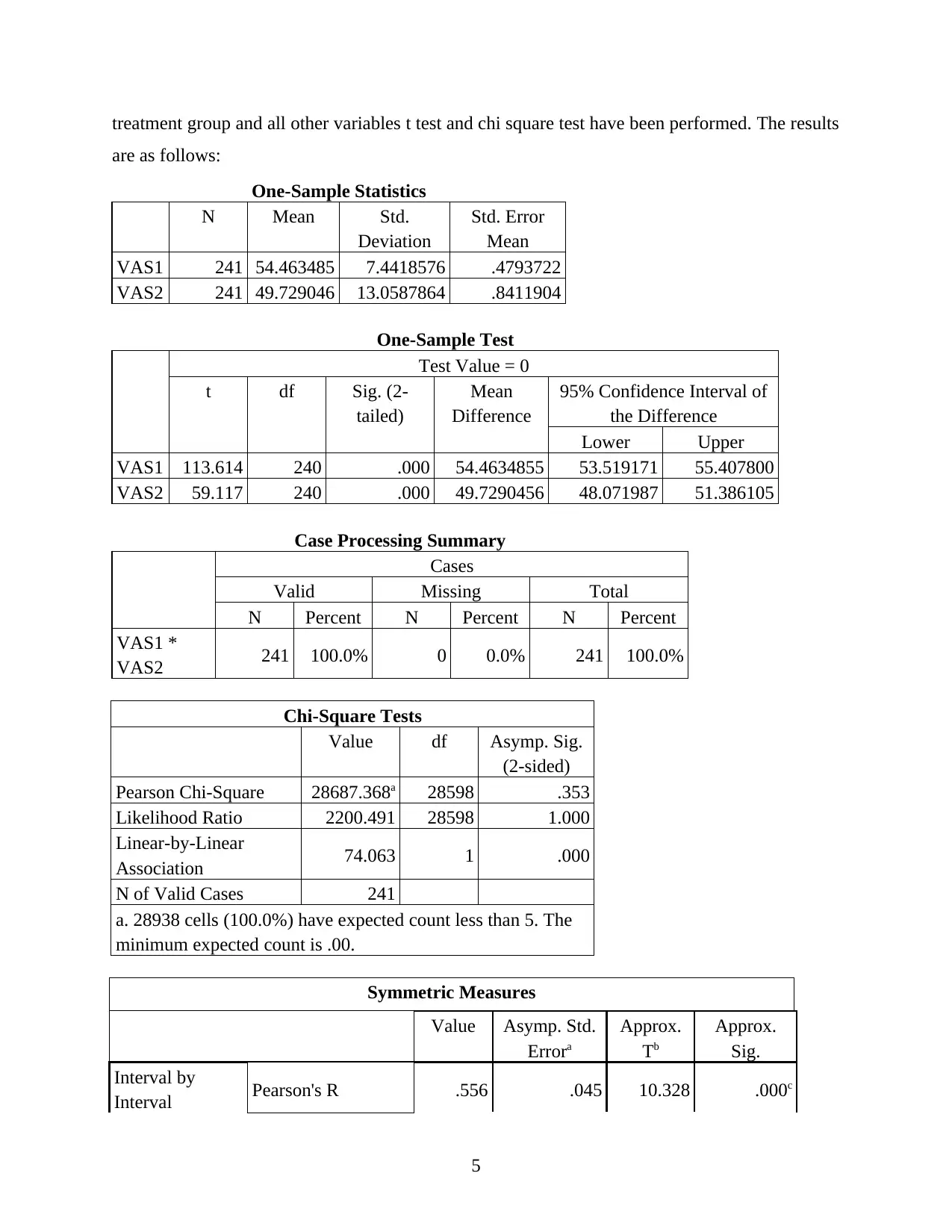
treatment group and all other variables t test and chi square test have been performed. The results
are as follows:
One-Sample Statistics
N Mean Std.
Deviation
Std. Error
Mean
VAS1 241 54.463485 7.4418576 .4793722
VAS2 241 49.729046 13.0587864 .8411904
One-Sample Test
Test Value = 0
t df Sig. (2-
tailed)
Mean
Difference
95% Confidence Interval of
the Difference
Lower Upper
VAS1 113.614 240 .000 54.4634855 53.519171 55.407800
VAS2 59.117 240 .000 49.7290456 48.071987 51.386105
Case Processing Summary
Cases
Valid Missing Total
N Percent N Percent N Percent
VAS1 *
VAS2 241 100.0% 0 0.0% 241 100.0%
Chi-Square Tests
Value df Asymp. Sig.
(2-sided)
Pearson Chi-Square 28687.368a 28598 .353
Likelihood Ratio 2200.491 28598 1.000
Linear-by-Linear
Association 74.063 1 .000
N of Valid Cases 241
a. 28938 cells (100.0%) have expected count less than 5. The
minimum expected count is .00.
Symmetric Measures
Value Asymp. Std.
Errora
Approx.
Tb
Approx.
Sig.
Interval by
Interval Pearson's R .556 .045 10.328 .000c
5
are as follows:
One-Sample Statistics
N Mean Std.
Deviation
Std. Error
Mean
VAS1 241 54.463485 7.4418576 .4793722
VAS2 241 49.729046 13.0587864 .8411904
One-Sample Test
Test Value = 0
t df Sig. (2-
tailed)
Mean
Difference
95% Confidence Interval of
the Difference
Lower Upper
VAS1 113.614 240 .000 54.4634855 53.519171 55.407800
VAS2 59.117 240 .000 49.7290456 48.071987 51.386105
Case Processing Summary
Cases
Valid Missing Total
N Percent N Percent N Percent
VAS1 *
VAS2 241 100.0% 0 0.0% 241 100.0%
Chi-Square Tests
Value df Asymp. Sig.
(2-sided)
Pearson Chi-Square 28687.368a 28598 .353
Likelihood Ratio 2200.491 28598 1.000
Linear-by-Linear
Association 74.063 1 .000
N of Valid Cases 241
a. 28938 cells (100.0%) have expected count less than 5. The
minimum expected count is .00.
Symmetric Measures
Value Asymp. Std.
Errora
Approx.
Tb
Approx.
Sig.
Interval by
Interval Pearson's R .556 .045 10.328 .000c
5
Paraphrase This Document
Need a fresh take? Get an instant paraphrase of this document with our AI Paraphraser
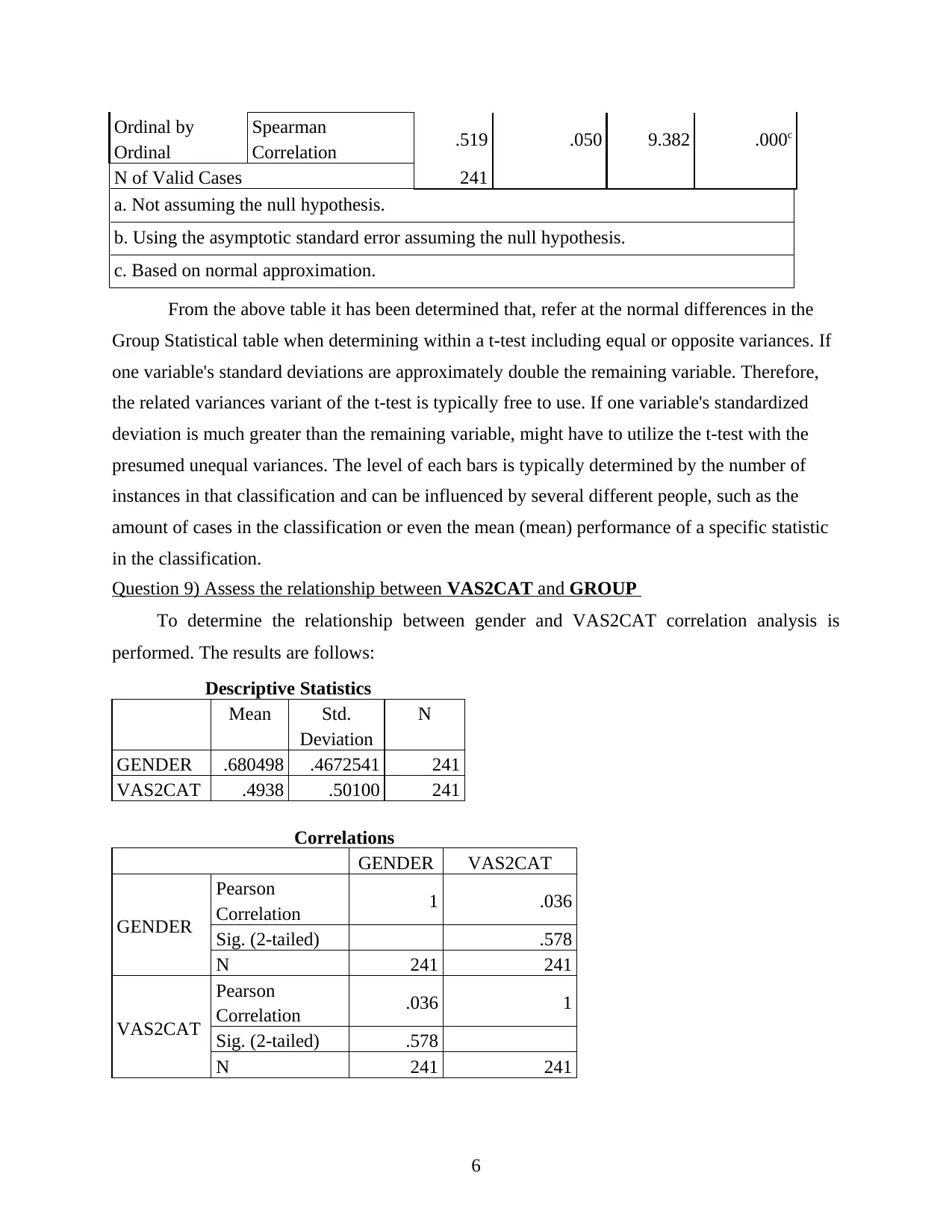
Ordinal by
Ordinal
Spearman
Correlation .519 .050 9.382 .000c
N of Valid Cases 241
a. Not assuming the null hypothesis.
b. Using the asymptotic standard error assuming the null hypothesis.
c. Based on normal approximation.
From the above table it has been determined that, refer at the normal differences in the
Group Statistical table when determining within a t-test including equal or opposite variances. If
one variable's standard deviations are approximately double the remaining variable. Therefore,
the related variances variant of the t-test is typically free to use. If one variable's standardized
deviation is much greater than the remaining variable, might have to utilize the t-test with the
presumed unequal variances. The level of each bars is typically determined by the number of
instances in that classification and can be influenced by several different people, such as the
amount of cases in the classification or even the mean (mean) performance of a specific statistic
in the classification.
Question 9) Assess the relationship between VAS2CAT and GROUP
To determine the relationship between gender and VAS2CAT correlation analysis is
performed. The results are follows:
Descriptive Statistics
Mean Std.
Deviation
N
GENDER .680498 .4672541 241
VAS2CAT .4938 .50100 241
Correlations
GENDER VAS2CAT
GENDER
Pearson
Correlation 1 .036
Sig. (2-tailed) .578
N 241 241
VAS2CAT
Pearson
Correlation .036 1
Sig. (2-tailed) .578
N 241 241
6
Ordinal
Spearman
Correlation .519 .050 9.382 .000c
N of Valid Cases 241
a. Not assuming the null hypothesis.
b. Using the asymptotic standard error assuming the null hypothesis.
c. Based on normal approximation.
From the above table it has been determined that, refer at the normal differences in the
Group Statistical table when determining within a t-test including equal or opposite variances. If
one variable's standard deviations are approximately double the remaining variable. Therefore,
the related variances variant of the t-test is typically free to use. If one variable's standardized
deviation is much greater than the remaining variable, might have to utilize the t-test with the
presumed unequal variances. The level of each bars is typically determined by the number of
instances in that classification and can be influenced by several different people, such as the
amount of cases in the classification or even the mean (mean) performance of a specific statistic
in the classification.
Question 9) Assess the relationship between VAS2CAT and GROUP
To determine the relationship between gender and VAS2CAT correlation analysis is
performed. The results are follows:
Descriptive Statistics
Mean Std.
Deviation
N
GENDER .680498 .4672541 241
VAS2CAT .4938 .50100 241
Correlations
GENDER VAS2CAT
GENDER
Pearson
Correlation 1 .036
Sig. (2-tailed) .578
N 241 241
VAS2CAT
Pearson
Correlation .036 1
Sig. (2-tailed) .578
N 241 241
6
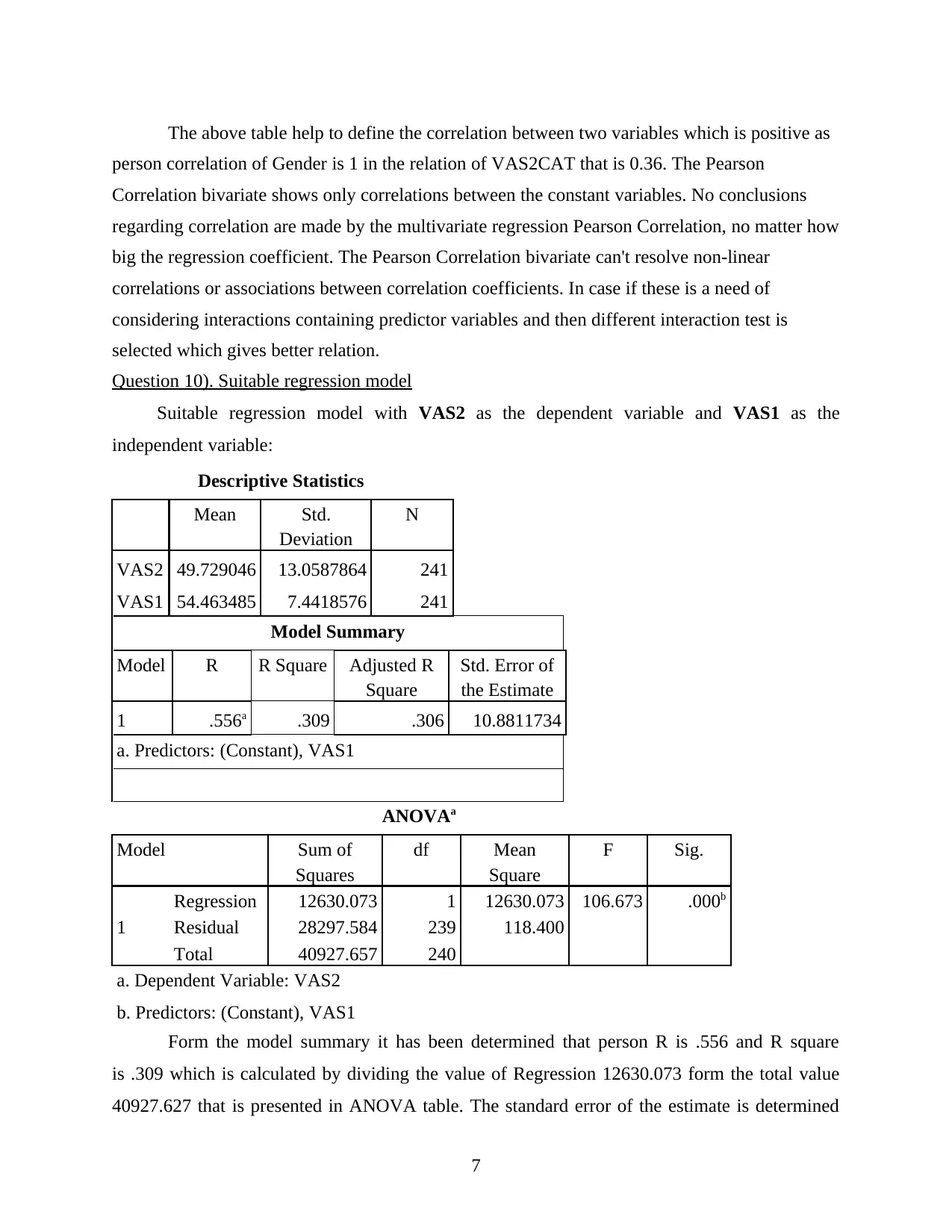
The above table help to define the correlation between two variables which is positive as
person correlation of Gender is 1 in the relation of VAS2CAT that is 0.36. The Pearson
Correlation bivariate shows only correlations between the constant variables. No conclusions
regarding correlation are made by the multivariate regression Pearson Correlation, no matter how
big the regression coefficient. The Pearson Correlation bivariate can't resolve non-linear
correlations or associations between correlation coefficients. In case if these is a need of
considering interactions containing predictor variables and then different interaction test is
selected which gives better relation.
Question 10). Suitable regression model
Suitable regression model with VAS2 as the dependent variable and VAS1 as the
independent variable:
Descriptive Statistics
Mean Std.
Deviation
N
VAS2 49.729046 13.0587864 241
VAS1 54.463485 7.4418576 241
Model Summary
Model R R Square Adjusted R
Square
Std. Error of
the Estimate
1 .556a .309 .306 10.8811734
a. Predictors: (Constant), VAS1
ANOVAa
Model Sum of
Squares
df Mean
Square
F Sig.
1
Regression 12630.073 1 12630.073 106.673 .000b
Residual 28297.584 239 118.400
Total 40927.657 240
a. Dependent Variable: VAS2
b. Predictors: (Constant), VAS1
Form the model summary it has been determined that person R is .556 and R square
is .309 which is calculated by dividing the value of Regression 12630.073 form the total value
40927.627 that is presented in ANOVA table. The standard error of the estimate is determined
7
person correlation of Gender is 1 in the relation of VAS2CAT that is 0.36. The Pearson
Correlation bivariate shows only correlations between the constant variables. No conclusions
regarding correlation are made by the multivariate regression Pearson Correlation, no matter how
big the regression coefficient. The Pearson Correlation bivariate can't resolve non-linear
correlations or associations between correlation coefficients. In case if these is a need of
considering interactions containing predictor variables and then different interaction test is
selected which gives better relation.
Question 10). Suitable regression model
Suitable regression model with VAS2 as the dependent variable and VAS1 as the
independent variable:
Descriptive Statistics
Mean Std.
Deviation
N
VAS2 49.729046 13.0587864 241
VAS1 54.463485 7.4418576 241
Model Summary
Model R R Square Adjusted R
Square
Std. Error of
the Estimate
1 .556a .309 .306 10.8811734
a. Predictors: (Constant), VAS1
ANOVAa
Model Sum of
Squares
df Mean
Square
F Sig.
1
Regression 12630.073 1 12630.073 106.673 .000b
Residual 28297.584 239 118.400
Total 40927.657 240
a. Dependent Variable: VAS2
b. Predictors: (Constant), VAS1
Form the model summary it has been determined that person R is .556 and R square
is .309 which is calculated by dividing the value of Regression 12630.073 form the total value
40927.627 that is presented in ANOVA table. The standard error of the estimate is determined
7
⊘ This is a preview!⊘
Do you want full access?
Subscribe today to unlock all pages.

Trusted by 1+ million students worldwide
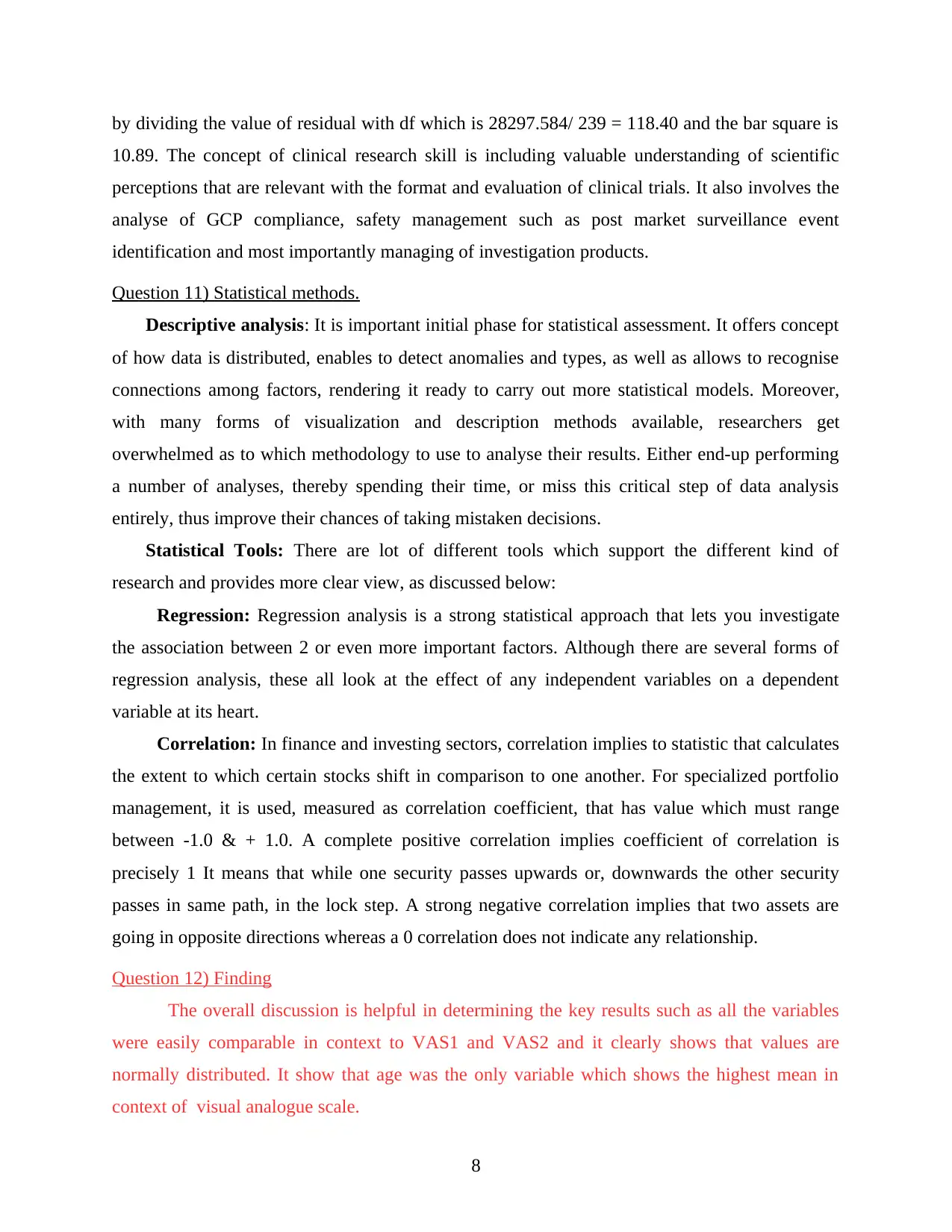
by dividing the value of residual with df which is 28297.584/ 239 = 118.40 and the bar square is
10.89. The concept of clinical research skill is including valuable understanding of scientific
perceptions that are relevant with the format and evaluation of clinical trials. It also involves the
analyse of GCP compliance, safety management such as post market surveillance event
identification and most importantly managing of investigation products.
Question 11) Statistical methods.
Descriptive analysis: It is important initial phase for statistical assessment. It offers concept
of how data is distributed, enables to detect anomalies and types, as well as allows to recognise
connections among factors, rendering it ready to carry out more statistical models. Moreover,
with many forms of visualization and description methods available, researchers get
overwhelmed as to which methodology to use to analyse their results. Either end-up performing
a number of analyses, thereby spending their time, or miss this critical step of data analysis
entirely, thus improve their chances of taking mistaken decisions.
Statistical Tools: There are lot of different tools which support the different kind of
research and provides more clear view, as discussed below:
Regression: Regression analysis is a strong statistical approach that lets you investigate
the association between 2 or even more important factors. Although there are several forms of
regression analysis, these all look at the effect of any independent variables on a dependent
variable at its heart.
Correlation: In finance and investing sectors, correlation implies to statistic that calculates
the extent to which certain stocks shift in comparison to one another. For specialized portfolio
management, it is used, measured as correlation coefficient, that has value which must range
between -1.0 & + 1.0. A complete positive correlation implies coefficient of correlation is
precisely 1 It means that while one security passes upwards or, downwards the other security
passes in same path, in the lock step. A strong negative correlation implies that two assets are
going in opposite directions whereas a 0 correlation does not indicate any relationship.
Question 12) Finding
The overall discussion is helpful in determining the key results such as all the variables
were easily comparable in context to VAS1 and VAS2 and it clearly shows that values are
normally distributed. It show that age was the only variable which shows the highest mean in
context of visual analogue scale.
8
10.89. The concept of clinical research skill is including valuable understanding of scientific
perceptions that are relevant with the format and evaluation of clinical trials. It also involves the
analyse of GCP compliance, safety management such as post market surveillance event
identification and most importantly managing of investigation products.
Question 11) Statistical methods.
Descriptive analysis: It is important initial phase for statistical assessment. It offers concept
of how data is distributed, enables to detect anomalies and types, as well as allows to recognise
connections among factors, rendering it ready to carry out more statistical models. Moreover,
with many forms of visualization and description methods available, researchers get
overwhelmed as to which methodology to use to analyse their results. Either end-up performing
a number of analyses, thereby spending their time, or miss this critical step of data analysis
entirely, thus improve their chances of taking mistaken decisions.
Statistical Tools: There are lot of different tools which support the different kind of
research and provides more clear view, as discussed below:
Regression: Regression analysis is a strong statistical approach that lets you investigate
the association between 2 or even more important factors. Although there are several forms of
regression analysis, these all look at the effect of any independent variables on a dependent
variable at its heart.
Correlation: In finance and investing sectors, correlation implies to statistic that calculates
the extent to which certain stocks shift in comparison to one another. For specialized portfolio
management, it is used, measured as correlation coefficient, that has value which must range
between -1.0 & + 1.0. A complete positive correlation implies coefficient of correlation is
precisely 1 It means that while one security passes upwards or, downwards the other security
passes in same path, in the lock step. A strong negative correlation implies that two assets are
going in opposite directions whereas a 0 correlation does not indicate any relationship.
Question 12) Finding
The overall discussion is helpful in determining the key results such as all the variables
were easily comparable in context to VAS1 and VAS2 and it clearly shows that values are
normally distributed. It show that age was the only variable which shows the highest mean in
context of visual analogue scale.
8
Paraphrase This Document
Need a fresh take? Get an instant paraphrase of this document with our AI Paraphraser

9
1 out of 11
Related Documents
Your All-in-One AI-Powered Toolkit for Academic Success.
+13062052269
info@desklib.com
Available 24*7 on WhatsApp / Email
![[object Object]](/_next/static/media/star-bottom.7253800d.svg)
Unlock your academic potential
Copyright © 2020–2025 A2Z Services. All Rights Reserved. Developed and managed by ZUCOL.




